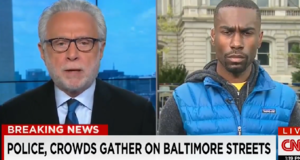From Cornell International Affairs Review VOL. 8 NO. 2Al Jazeera America and Strategic Responses to the "Perception Problem"And in choosing where to position their twelve regional bureaus, Al Jazeera America deputy launch director Paul Eedle explains, locations like Detroit and Nashville were chosen because, “We were looking for heartland locations” 36 These decisions make clear that Al Jazeera America intends to “build an American channel for an American audience” 37 What is less clear is whether Al Jazeera will simultaneously be able to “Americanize” while maintaining its distinct identity as an internationally renowned purveyor of high-quality, hard-hitting news. Although network executives gush that they hope to operate much like CNN – without being as sensational – and Fox News – without being as opinion-driven – a recent study from the Pew Research Center suggests that, in its most recent coverage, Al Jazeera America’s reporting differed little from its competitors’ broadcasts 38.“Americanization,” in content and tone as well as in name, thus functions as Al Jazeera America’s central strategy. Alongside shifts in its content and staff, Al Jazeera America executives have launched a massive marketing effort to publicly rebrand “Al Jazeera” in the hopes of making the network more attractive to Americans. “Everyone acknowledges, all the way up to the top, that there’s a tremendous branding and image cliff to climb among a certain audience segment,” admits Al Jazeera America correspondent Paul Beban 39. To accomplish this daunting task, the network has hired well-established lobbying and consulting firms like Qorvis Communications, Siegel & Gale, ASKG Public Strategies, and DLA Piper to represent the network’s interests in the nation’s capital and advise the network on its media relations. Their goal is to convince both politicians and plebians alike of Al Jazeera America’s “Americanism.” These attempts to solve Al Jazeera America’s “perception problem,” however, have met with internal opposition from some employees. They feel that pressure from corporate advisers has already forced Al Jazeera America to compromise its mission. Glenn Greenwald of The Guardian laments that, rather than embracing the “traditional attributes that have made Al Jazeera…an intrepid and fearless news organization,” Al Jazeera America has caved to its consultants and instead replicated the “inoffensive, neutered, voiceless, pro-US-government model…as a way of appeasing negative perceptions associated with the Al Jazeera brand in the US” 40. Greenwald argues that the rebranding efforts of Al Jazeera America have done little but rob the channel of its vibrancy and edginess. He quotes Al Jazeera journalist Marwan Bishara to drive home his point: “How we have moved,” Bishara seethes, “from the main idea that the strength of Al Jazeera lies in diversity [and] plurality” 41. In order to distance itself from Al Jazeera’s flagship branch as well as Al Jazeera English, Al Jazeera America appears to be relying on corporate sponsors to enhance its public image as “American through and through” 42. Because Al Jazeera in many ways represents to Americans “the culture, the perspectives and the news-editorial style of the entire [Arab] region” — a broad list of associations to which religion can also be added — it is tempting to describe the public opinion obstacles faced by Al Jazeera America as somehow prototypical, or at least illustrative, of the social and political challenges faced by American Muslims since September 11, 2001 43. This observation begs the following question: are the adaptive strategies Al Jazeera America has employed to overcome negative perceptions representative of the everyday tactics used by millions of American Muslims to win greater recognition and respect from their fellowAmericans? In other words, can Al Jazeera America and American Muslims solve their common “perception problem” the same way? To answer this question, the following section turns to a comparative description of the biases faced by Muslims living in contemporary America. In the post-9/11 world, both Al Jazeera America and American Muslims have borne the weight of the American mainstream’s distrust and disapproval. Since the terrorist attacks on the Twin Towers, Muslims have endured hostility from many different corners of American public life. They have been labeled “the enemy within” by political pundits and conservative commentators, targeted in President George W. Bush’s demonizing “crusades-talks,” and attacked by the perpetrators of hate crimes 44. The disapprobation directed towards American Muslims can also be diagrammed along the three analytic axes of national security, public discourse, and globalization. To begin, federally mandated racial-religious profiling and raids on “extremist” mosques effectively implied to the American people that the Muslims who lived next door could potentially be “enemies of the state” intent on destroying the American way of life. After the 9/11 attacks, conditions of acute insecurity and fear contributed to increasing xenophobia and intolerance towards American Muslims 45. Many – but not all – U.S. news outlets upped their vitriol, spreading damning stereotypes and misinformation that equated Islamism with Arabism with terrorism. During this time, public discourse demonstrated an increased tendency to essentialize and isolate American Muslims by drawing upon existing narratives of “otherness” that sometimes went so far as to portray Muslims as “anti-democratic, anti-Semitic, [and] anti-rational” 46. “No other world religion,” writes Karen Leonard, “has ever been attacked and rendered evil in the history of America” 47. Finally, the antipathy for American Muslims that escalated after 9/11 continued to reflect certain realities of globalization. In the period of “existential insecurity” following the attacks on the Twin Towers and the Pentagon, the news media contributed to the perception that American Muslims were “drowning out, washing out, or overpowering American citizens, and thus representing a threat to the American way of life” 48. In this context, the mosque across the street — a symptom of the transnational spread of cultures, values, and peoples — indicated not diversity, but criminality. A 2008 public opinion poll in the Los Angeles Times serves as a fitting conclusion: the majority of Americans (66%) admit to having “at least some” prejudice against Muslims, one in five say they have “a great deal” of prejudice against Muslims, almost half do not believe American Muslims are “loyal” to this country, and one in four “do not want a Muslim as a neighbor” 49. Clearly,American Muslims are suffering from an “image problem” that mirrors the negative perceptionsAmericans have of Al Jazeera. In addition to facing similar obstacles in the realm of public opinion, Al Jazeera America and American Muslims also have the same abstract goal: “voice.” Sheikh Tamim bin Hamad Al Thani directs the growth of his media empire not for profit, but rather to increase Qatar’s “soft power” 50. By enhancing the size and credibility of the Al Jazeera Media Network – even if the expansion produces a financial loss – the Emir of Qatar stands to increase the relative “voice” Qatar can leverage on the global stage 51. Abstractly, American Muslims’ goal is also “voice.” As a minority population in a democratic polity, American Muslims are inherently at a greater risk of suffering political alienation, defined here as a sense of “powerlessness, meaninglessness, normlessness, isolation, and self-estrangement” derived primarily from an individual and collective inability to be heard and acknowledged in the majoritarian political processes 52. Achieving “voice” in a political system has both tangible and intangible benefits: it increases the likelihood that a government will pass policies responsive to the needs of the minority group, and it also enhances the sense of belonging minorities feel in their communities. To the extent that Al Jazeera America and American Muslims find that the accusations of anti-American sentiment lodged against them hinder the strength of their respective “voices,”both entities will have powerful incentives to rectify the deficit. Although Al Jazeera America and American Muslims face similar obstacles in the realm of public opinion and have the same abstract aim, this paper argues that because Al Jazeera America and American Muslims operate under very different procedural constraints for achieving their strategic goals, it would be unwise to assume their respective responses to prejudice are equivalent. Differences in these procedural restraints condition how Al Jazeera America and American Muslims attempt to acquire recognition and respect in the public sphere. Taking a certain level of “existential insecurity” in the American public as a given, this paper proposes that for groups distrusted in the public sphere, voice – which I define loosely as “popularity” – can only be amplified at the expense of principle (as long as that principle is the source of the “existential insecurity” at hand). Analysis of Al Jazeera America’s strategic responses to rectify their “perception problem” support this interpretation. In order to increase the network’s “popularity” and thus enhance its soft power, executives at Al Jazeera America have compromised on multiple aspects of its identity that might have risked the American public perceiving the network as having “terrorist ties.” Therefore, although the channel still “uses the well-known Al Jazeera logo,” Al Jazeera Americahas distanced itself from its English and Arabic sister and parent networks and substantially altered its staff and content to reflect a relatively unquestioning American worldview 53. Al Jazeera America, one insider noted, has lost the struggle for its identity; rather than operating as its own unique “critical movement that could speak for millions of people,”the outfit is now essentially an imitation of mainstream U.S. news networks like MSNBC and CNN 54. Given this, it can be seen that the most important difference between Al Jazeera America and American Muslims – what renders moot a comparison of the entities’ strategic responses to prejudice – is that American Muslims are on the whole unwilling to compromise their principles – a key facet of their collective identity – to achieve popularity. While there must inevitably be exceptions to this rule, the enhanced rather than depressed expression of Muslim identity after September 11, 2001 provides evidence for this claim. After 9/11, one might have reasonably expected American Muslims to respond to the public’s “existential insecurity” by compromising on their “principles” and seeking to increase their relative assimilation in mainstream society. On the contrary, Lori Peek reports that during this period most Muslims “continued to publicly affirm their religious identities. Indeed, many participants reported that their religious identity became even stronger during this time” 55. Although American Muslims would like to amplify their influence in the public sphere, they are largely unwilling to compromise on certain facets of their identity and tenets of their beliefs to increase their “voice.” And while many American Muslims are well integrated into American society, a post-9/11 renewed emphasis on Muslim identity demonstrates a dedication to principle over popularity. In contrast, Al Jazeera America appears to have dispensed quickly with some of its core principles in order to enhance its popularity, viewing this exchange as a favorable trade-off. For these reasons, it would bemisguided to assume that the same strategic decisions made by Al Jazeera America to appeal to its American audiences might be applicable to the decision-making of American Muslims faced with similar public disapprobation. In summary, this essay has outlined a brief history of the Al Jazeera Media Network and identified the conditions that produced its subject: Al Jazeera America. It employed three explanatory perspectives – national security, public discourse, and globalization – to analyze the American public’s skepticism and disapproval of Al Jazeera America. Based on existing literature about the rookie network, it identified four primary areas – entry, principles, content, and branding – in which Al Jazeera American has attempted to strategically combat its troublesome “image issues.” Finally, it engaged with a theoretical question: are the conciliatory strategies Al Jazeera America employs to overcome negative perceptions reflective of the everyday tactics used by American Muslims to address their own “perception problems”? It argued that while Al Jazeera America and American Muslims both aim to amplify their“voice,” American Muslims are ultimately far less likely than the news network to compromise their principles for the sake of popularity. Therefore, Al Jazeera’s strategic responses to the “perception problem,” many of which are best characterized as assimilatory “identity concessions,” do not point towards viable solutions for American Muslims. ReferencesAleaziz, Hamed. “Study: Anti-Islam Messages Dominate Media Coverage.” ThinkProgress. 1 Dec. 2012. Web. 17 Apr. 2015. “Al ¬Jazeera America to Have Bureaus in Cities Where Other Networks Don’t, including Nashville.” Associated Press Newswires 5 May 2013. Factiva. Web. 3 May 2014. Al-Jaber, Khalid. The Credibility of Arab Broadcasting: The Case of Al Jazeera. Dawḥah: National Council, Arts and Heritage, Dept. of Culture & Arts, 2004. Ariens, Chris. “Al Jazeera America Now on Time Warner Cable, Bright House Networks.” Me diaBistro.com. TVNewser, 6 Dec. 2013. Web. 24 Apr. 2014. Austin, Paige. “Double Vision: Al Jazeera English at Odds with the American Media.” Harvard Kennedy School Review Media and Technology 10 (2009-2010): 34-39. Barkho, Leon. “The Discursive and Social Power of News Discourse: The Case of Aljazeera in Comparison and Parallel with the BBC and CNN.” Studies in Language & Capitalism 3.4 (2008): 111-59. Beck, Glenn. “The Worst of Al Jazeera.”Glenn Beck: The Fusion of Enter- tainment and Enlightenment, 20 Aug. 2013. Web. 3 May 2014. “Bieber’s Barely a Blip on Al Jazeera America; Network Hopes Watchers Want Real Hard News.” USA Today 28 Jan. 2014. Factiva. Web. 3 May 2014. Burman, Tony. “Al Jazeera America Has the Odor of Disaster.” The Toronto Star, 1 June 2013. Web. 2 May 2014. Fletcher, Fred, and Mary L. Young. “Political Communication in a Changing Media Environ ment.” The SAGE Handbook of Political Communication. By Holli A. Semetko and Margaret Scammell. Los Angeles: SAGE, 2012. Funt, Peter. “Welcome, Al Jazeera.” Monterey County Herald [California] 19 Aug. 2013. Dickey, Christopher. “The Al Jazeera Revolution.” Newsweek, 23 May 2013. Web. 2 May 2014. Enda, Jodi, and Emily Guskin. “Al Jazeera America’s Biggest Challenge: ‘Getting People to Show Up’” Pew Research Center, 28 May 2013. Web. 24 Apr. 2014. Esposito, John L., and Dalia Mogahed. “Muslim True/false.” Los Angeles Times 2 Apr. 2008. Garvin, Glenn. “Keep A Skeptical Eye On Al Jazeera America.” Pittsburgh Post-Gazette 3 Sept. 2013, Pittsburgh Press ed. Gest, Justin. Apart: Alienated and Engaged Muslims in the West. London: Hurst, 2010. Greenwald, Glenn. “Inside Look at the Internal Strife over Al Jazeera America.” The Guardian [UK] 14 July 2013. Factiva. Web. 3 May 2014. Hall, Stuart. “The Local and the Global: Globalization and Ethnicity.” Culture, Globalization and the World System: Contemporary Conditions for the Representation of Identity. By Anthony D. King. Basingstoke: Macmillan Education, 1991. 19-39. Hanley, Delinda C. “Al Jazeera English: The Brave New Channel They Don’t Want You to See.” Washington Report on Middle Easte Affairs 26.7 (2007): 24-25. EBSCO. Web. 15 Apr. 2014. Ibish, Hussein. “Symptoms of Alienation: How the Arab and American Media View Each Other.” Arab Media in the Information Age. Abu Dhabi: Emirates Center for Strategic Studies and Research, 2006. Inglehart, Ronald, and Pippa Norris. Muslim Integration into Western Cultures: Between Origins and Destinations. 28 Feb. 2009. Lahlali, El Mustapha. Contemporary Arab Broadcast Media. Edinburgh: Edinburgh UP, 2011. Leonard, Karen Isaksen. Muslims in the United States: The State of Research. New York: Russell Sage Foundation, 2003. Lieberman, David. “Al Jazeera English Gains Cachet in USA.” USA Today 7 Feb. 2011. EBSCO.Web. 15 Apr. 2014. Martinez, Michael. “Once Called ‘Terror Network,’ Al Jazeera America Dares to Enter U.S. Cable Market.” CNN Wire 4 Jan. 2013: Factiva. Web. 3 May 2014. May, Clifford D. “The Case Against Al Jazeera America.” Sentinel & Enterprise [Fitchburg, MA] 11 Jan. 2013. “Cautious of Al Jazeera America.” Ventura County Star [Ventura, CA] 28 Aug. 2013. Factiva. Web. 3 May 2014. Ostrow, Joanne. “Al Jazeera America Faces an Image Problem.” The Denver Post 18 Aug. 2013. Factiva. Web. 3 May 2014. Peek, Lori. “Becoming Muslim: The Development of Religious Identity.” Sociology of Religion 66.3 (2005): 215-42. JSTOR. Web. 8 Sept. 2010. Pine, Adrienne, and Keane Bhatt. “As Al Jazeera America Launches, Concerns Over Corporate-Driven Agenda Persist.” Truth Out, 31 Aug. 2013. Web. 2 May 2014. Pompeo, Joe. “Al Jazeera America: A Unicorn Is Born.” Daily Intelligencer. New York Magazine, 11 July 2013. Web. 24 Apr. 2014. Rash, John. “Al Jazeera Aspires Higher than Cable Competitors.” Star Tribune [Minneapolis, MN] 24 Aug. 2013. Rieder, Rem. “Al Jazeera America Not Unlike Rivals.” USA Today 17 Sept. 2013. Factiva. Web. 3 May 2013. Rushing, Josh, and Sean Elder. Mission Al Jazeera: Build a Bridge, Seek the Truth, Change the World. New York: Palgrave Macmillan, 2007. Said, Edward, “Islam Through Western Eyes.” The Nation, 26 Apr. 1980. Seib, Philip M. Al Jazeera English: Global News in a Changing World. New York: Palgrave Macmillan, 2012. Steel, Emily. “Ehab Al Shihabi, Al Jazeera’s quiet American.” Financial Times, 15 Dec. 2013. Web. 24 Apr. 2014. Steinberg, Brian. “Al Jazeera America Chief Sees Challenges Ahead.” Variety, 15 Aug. 2013. Web. 3 May 2014. Stelter, Brian. “Al Jazeera America Promises a More Sober Look At the News.” The New York Times, 18 Aug. 2013. Web. 24 Apr. 2014. “Al Jazeera America Shifts Focus to U.S. News.” The New York Times, 26 May 2013. Web. 24 Apr. 2014. Swanson, Emily. “Poll On Time Warner Dropping Current TV Finds Plurality Approve.” The Huffington Post, 7 Jan. 2013. Web. 4 May 2014. “This Crusade Is Gonna Take A While: 9/11 George Bush” (Sept 17 2001). YouTube. 28 Dec. 2013. Web. 17 Apr. 2015. West, Diana. “When Will the Media Notice That Al-Jazeera America Is the Muslim Brotherhood Channel?” The Daily Times [Farmington, NM] 26 Aug. 2013. Zayani, Mohamed, and Sofiane Sahraoui. The Culture of Al Jazeera: Inside an Arab Media Giant. Jefferson, NC: McFarland, 2007. Endnotes
Suggested Reading from Inquiries Journal
Inquiries Journal provides undergraduate and graduate students around the world a platform for the wide dissemination of academic work over a range of core disciplines. Representing the work of students from hundreds of institutions around the globe, Inquiries Journal's large database of academic articles is completely free. Learn more | Blog | Submit Latest in Business & Communications |



















